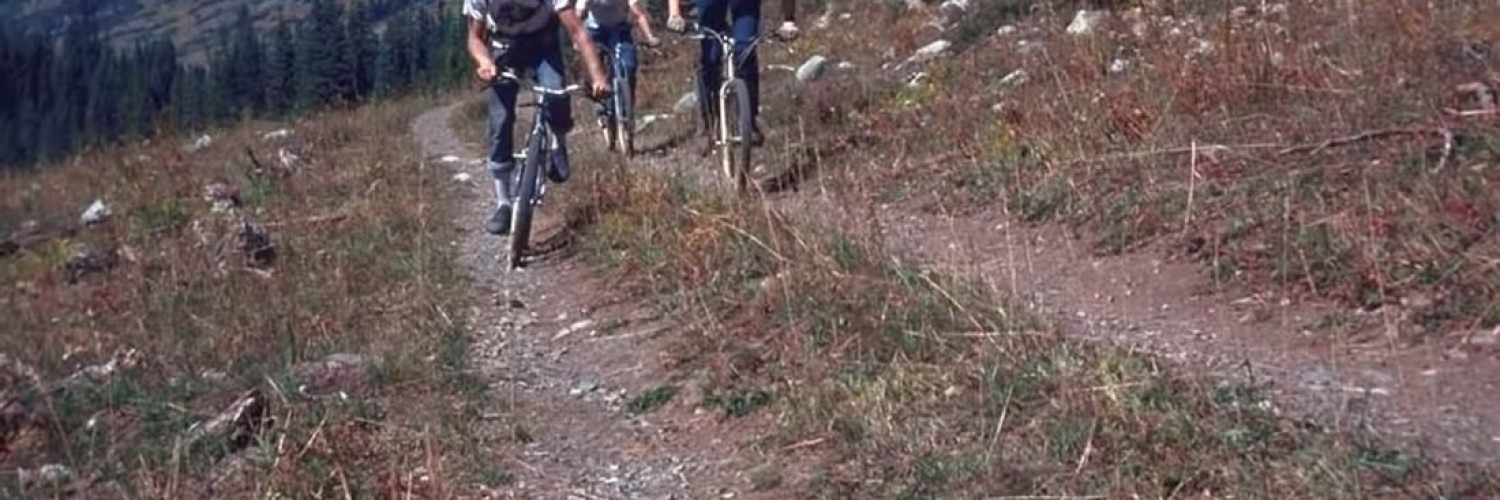Pearl Pass Tour
From September 17, 1976 Crested Butte Pilot
Since the Crested Butte Klunker Tour to Aspen over Pearl Pass last weekend was the first event of its kind on the western slope and possibly in all of Colorado, the Pilot wishes to bring you a blow by blow account of the trip. Our thanks for the following tale of the trail to Bob Starr and Rick Verplank.
Fifteen klunker riders (perhaps we should explain that a klunker is a no-speed bicycle comprised of only the essentials – fat tires, handlebars, pedals and a chain) left the Grubstake with a cheer Friday morning at 9. I heard them because I live next door and didn’t make it out of bed to take a going away photo.
Everyone began dropping like flies up the Brush Creek Road, but seven hardy riders made it to base camp located three miles below the pass summit. The seven included Bob Starr, Rick Verplank, Walter Keith, Long Beach, Patty Ann Gifford, Patty Christie and Duane Reading. They were soon joined by the support vehicles driven by Doug the Bump, Ed Bliss, Abe, and Cotton Harris containing the drop-outs and the Klunker groupies, including Chris Whitsell, president of the Groupie Club. The group and groupies made camp, enjoyed a steak fry and consumed one keg of beer, three bottles Schnapps, 2 gallons of wine, and 3 bottles of champagne. Mechanical assistance was rendered by Steve Baker, head engineer. Then, according to Starr, everyone got drunk and passed out on the pass. Saturday morning dawned under gray skies and a drizzle. The tour members sprung up bright and early only to find someone had raided the donut stash during the night. Everyone was checked for doughnut breath. No luck, the culprit remained at large.
Verplank and Starr then began pushing their klunkers to the top and over the pass, outracing the support vehicles. Richard Ullery became at that point the first man in history to cross Pearl Pass in a bathtub. The historical tub may be viewed in the back of Ed Bliss’ truck (minus Ullery)
“The decent was nothing but horrifying, rough and rocky.” Said Starr. “The original drop-outs jumped out of support vehicles at the tip and all 15 rode their klunkers down the pass until just before the pavement at Ashcroft where the brakes were smoking and rear ends were seizing up.”
“The conservative tortoise types cruised past the burning up hares, as it were.” Said Starr, and “we trickled in one by one, met at the Jerome Hotel and had a party all over Aspen.”
It should be emphasized that Verplank and Starr were actually the only ones of the original 15 who officially made the Tour. They never once rode in a support vehicle.Verplank expressed his gratitude to several Aspen ladies, plus Ken Oakes, at whose house the keg was finished off. “Everyone had a really good time and we expect three times as many bikes next year,” he said. Added Starr, “We’re trying to get a grant from the National Geographic Society to go over to the Andes.”
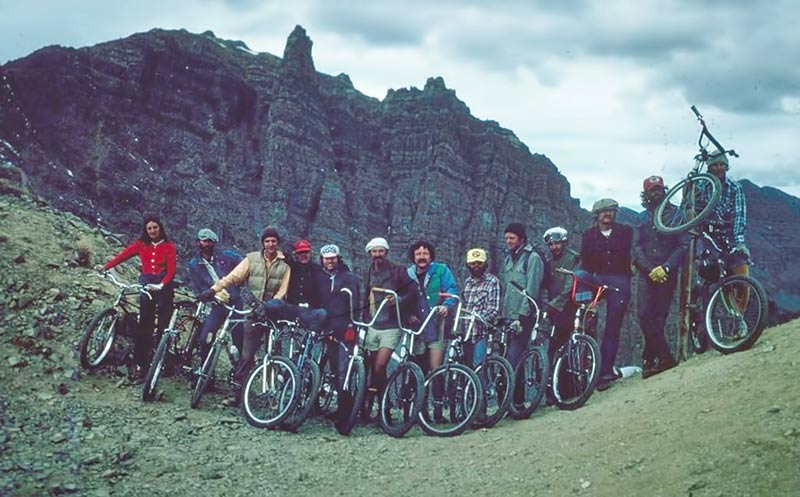 A Race Is Nice, But a Tour Has Spice
A Race Is Nice, But a Tour Has Spice
Pearl Pass, Colorado, elevation 12,700 feet, September 1978. Wende Cragg photo
From left, Wende Cragg, Neil Murdoch (Richard Bannister) Richard Nilsen, who wrote the article about these bikes for the Co-Evolution Quarterly, Charlie Kelly, Joe Breeze, Jim Cloud, Bob Starr, Richard Ullery, Gary Fisher, Archie Archuleta, Chris Carroll, Albert Maunz, and Mike Castelli, who took the photos for the Co-Evolution Quarterly article. Courtesy of Charlie Kelly
Crested Butte 3rd Annual Klunker Tour, September 29, 1978, Crested Butte Pilot
For the first time in history out-of-town riders compete in the annual Crested Butte to Aspen via Pearl Pass Klunker Tour. In addition to eight Crested Butte Klunker enthusiasts, five riders from Marin County, California, one from Hotchkiss, Colorado and one from Denver assembled at the starting line at 10 A.M. on Friday. As usual, the tour began in front of the Grubstake Bar and Grill on historic Elk Avenue in Crested Butte. After some early delay and a flurry of photographs, the tour departed over an hour late.
Shortly after the tour departure, the first mishap occurred: a flat rear tire on Dick “Archie” Archuletta’s klunker. The California boys immediately jackknifed into action. Tools selected after years of experience glimmered in the sunlight as the intrepid Californians removed the wheel, replaced the tube, tuned the spokes, remounted the wheel, slacked the cones a tad, adjusted the chain and had Arch’s bike back on the road in 35 second s flat.
If there was any doubt before, the local rider’s here-after realized that they were not dealing with amateurs. In fact, the Californians sported some of the finest Klunkers to be found anywhere in the world. Their bikes are– in a word – sophisticated: hand-brazed, thin-wall, chrome-moly tubing which is plated, not painted. “Paint chips, you know,” commented one California rider. The Californian machines are equipped with a 12-speed, thumb-change gearing and fore and aft centerpull brakes. This superior equipment allowed the California contingent to ride almost all the way up the pass. The Crested Butte riders, on the other hand, spent most of the climb pushing their first –generation, one-speed Schwinn Klunkers the ten miles up the pass to camp, which was at the base of the switchbacks at Pearl Pass. Duane Reeding, who piloted the supply truck to camp, provided the exhausted, famished riders with dinner. Liquid refreshment, one keg of cold Coors beer, was provided by Ms. Judy Naumburg, proprietess of the Grubstake.
Refreshed by a good night’s sleep and a delicious breakfast, the riders made their way swiftly to the top of the pass—12, 705 feet above sea level. Under a gray, cloudy sky and with a brisk, cold autumn wind at their backs, the riders exchanged toasts of water (that’s the wonderful beverage that makes the brewing of beer possible) and gathered for the traditional top-of-the-pass photographs. The ride down the pass is of course the essence of the tour. The descent through paths of rocks, varying in size from softballs to washtubs, is punishing on both bodies and equipment. Once again, the California machines led the way down the steep pass.
One Crested Butte rider, Richard Allery, riding a typical Crested Butte Klunker (your basic Schwinn with Bendix coaster brakes designed to stop a 60-pound newsboy on a level city street), experienced a brake failure one-fourth of the way down the pass. Undaunted, Allery continued the descent, jamming his foot between the frame and front wheel to slow his bike. When this became unfeasible, Richard began driving his Klunker against cliffs to control his descent. Finally forced to walk his bike, Allery said, “I felt gypped by the tour”. However, Allery did admit to “taking the bumps” in fine style before his Klunker failed him. He says that he will be back next year with “different brakes and maybe some gears.”
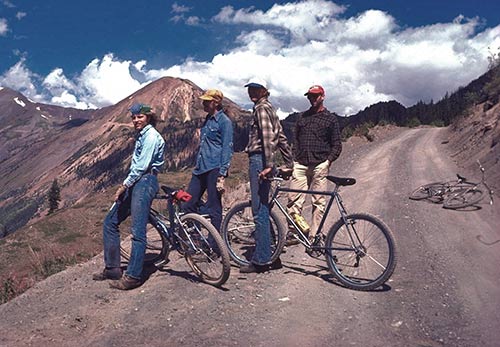 Near the historic town of Ashcroft, pavement welcomes the weary rider on the last phase of the tour. The road ahead into Aspen is one of easy-going and high speeds. Top speed on a Klunker is about 35 miles an hour. The tour made one last stop several miles outside Aspen to afix balloons to their Klunkers before the last sprint to the Pub in Aspen, where they celebrated the tour’s end. The riders were transported back to Crested Butte courtesy of Bruce “the face” Newman, who loaned his truck and Kirk Jones, who piloted the vehicle.
Near the historic town of Ashcroft, pavement welcomes the weary rider on the last phase of the tour. The road ahead into Aspen is one of easy-going and high speeds. Top speed on a Klunker is about 35 miles an hour. The tour made one last stop several miles outside Aspen to afix balloons to their Klunkers before the last sprint to the Pub in Aspen, where they celebrated the tour’s end. The riders were transported back to Crested Butte courtesy of Bruce “the face” Newman, who loaned his truck and Kirk Jones, who piloted the vehicle.
This years tour organizer, Bob Starr, was generally pleased with the tour, although he admits that some early confusion in the tour would probably be frowned up by R.A. Verplank—from whose crazed mind sprung the idea of the tour three years ago. Starr said the California riders would be back in force next year. Among those participants in this tour from Crested Butte were: Bob Starr, Albert Maunz, James Loud, Archie Archuletta, Richard Ullery, Neil Murdock, Chris Carroll, and Susan Hussemann. We understand from a reliable source that Gary Fisher, associate editor of Bicycling Magazine, flew in from New York for the tour. Fisher’s appearance, coupled with the Marin County, California participants, made this years tour a coast-to-coast event.
Also notable in this years running of the tour was the presence of a young lady from California named Wendy at the finish line. Although there have been six women entrants in Klunker tours before, this marks the first time in history that a lady finished the grueling tour.
1979 Pearl Pass Tour
A year after the above Pearl Pass photo was taken, the crowd has grown. Charlie Kelly’s on the cover of Bicycling along with a lot of other people in this photograph from the top of Pearl Pass in 1979, wearing a blue sweater and yellow hat fourth from the left. Next to me is Wende Cragg, then Chris McManus and Joe Breeze. Gary Fisher is fifth from the right and Alan Bonds is on the extreme right.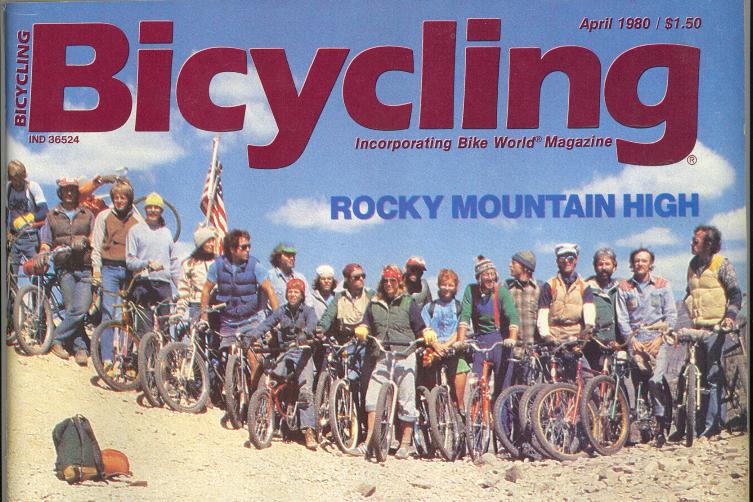
Courtesy of Charlie Kelly
Read About the Pearl Pass Tour and much more from Charlie Kelly’s Perspective:
Rocky Mountain Revelry or Crested Butte to Aspen in Only Two Days
Crested Butte, Colorado, a small town located high in the Rockies, is the scene of what is certainly one of the most unusual bicycle rides in this country. Not to be confused with ordinary (i.e. traditional) bike touring, this ride is an expression of exuberance by a unique community of free spirits, taking place over some of the roughest terrain ever ridden.
Crested Butte is an isolated town of 1500 population surrounded by peaks ranging from 12,000 to over 14,000 feet. There are only two paved streets here, and even a lazy cyclist could ride completely around the town in ten minutes.
Under these conditions a $1000,19 lb., handcrafted Italian jewel of a bicycle is practically useless, so most of the citizenry is equipped with some form of “clunker” bike, assembled from whatever parts are available. While the local bike shop has a limited access to new parts, the main supply of components comes from infrequent excursions to Denver for old parts, the Denver dump being a main supplier.
The people of Crested Butte are as individualistic a collection as can be found. Several years ago a group from Aspen rode motorcycles over 12,700 foot Pearl pass and parked them in front of the Grubstake Saloon in Crested Butte.
Seeing this, the locals decided to ride their clunkers over the pass and park them in similar fashion in front of the biggest bar in Aspen, not so much because it would be fun, but because it looked impossible.
This first epic ride was carried off in fine style, and the ride became a loosely annual event sponsored by a local bar, the Grubstake Saloon. Word of the event eventually made its way to California, where a number of us had been experimenting with cross-country bicycles. Seeing an opportunity to ride a unique tour, five of us traveled to Colorado to take part in what turned out to be a unique cycling experience.
Entering Crested Butte, on a beautiful afternoon, our first impression was that everyone in town owned a bike. Most machines are products of many years of crossbreeding. A ten-speed, for example, may be modified by the addition of fatter tires, a banana seat, and high rise handlebars so that a person may sit properly upright and observe his surroundings.
Since the streets are rough and the distances short, balloon tire bikes with coaster brakes are more popular than multi-speeds. The average speed of a cyclist in Crested Butte is barely enough to keep the machine upright and the stately and graceful.progress of the citizens, especially the ladies, is itself an argument against the use of the automobile.
Our arrival with a truckload of bikes did not go unnoticed and soon we had met many of the locals, all of whom were surprised that we had traveled so far just to take a bike ride. One thing led to another, and within hours of our arrival we found ourselves being interviewed on the town radio station.
Local interest in the ride, which had been flagging, began to pick up. After the interview, Duane Reading, manager of the Grubstake and one of the organizers of the Aspen ride, took us out to one of the most popular local riding spots, aptly named the “Ride to Die.”
We all piled into a pickup, which took us to the top of a beautiful ridge outside of town, then rode downhill five or six miles back to Crested Butte through a spectacular valley.
The “Ride to Die” road begins with a very rough section paved entirely with loose rock, then becomes a smooth dirt road. It is a steep descent from the ridge top and everyone rides as fast as possible. Perfect timing is required to lift the bike at high speed over the deep erosion ditches that occasionally cut across the road.
Near the bottom of the ridge we test the limits of adhesion on a series of S-turns, then we are rolling smoothly along the valley floor. Beaver dams every 100 feet or so along the stream and the aspens turning fall colors on the glacier-carved hillside give the scene an unreal beauty in the late afternoon sunlight.
As we roll along we inadvertently drive a few dozen cattle before us for a few hundred yards, then Joe swings off the road and herds them uphill while we shoot by. After three or four miles of easy riding Crested Butte comes into sight and we regroup at the Grubstake.
The next morning dawns warm and clear, and interest in the tour manifests itself in frantic bike repairs spread all over front lawns. Due to the unavailability of new parts, some bikes are ruthlessly pirated in order that others might live. It is this process which leads to the singular appearance of Crested Butte bicycles.
Since the tour starts on the following morning, these 11th hour efforts leave little time for testing of the results, leading to later difficulties in the field.
Later that evening most of the locals gather in the Grubstake for what appears to be some sort of purification ritual. In Crested Butte, purification follows petrification.
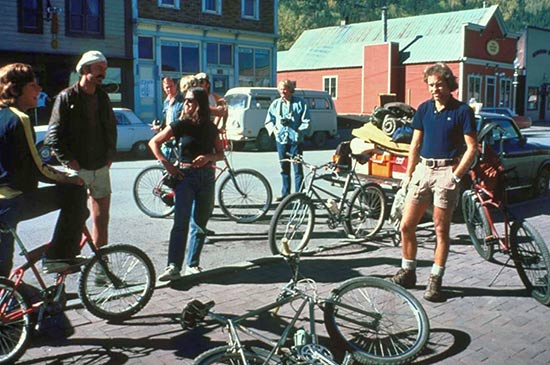 Saturday morning arrives at last, and around 10 AM we amble down to the Grubstake. There we find a dozen or so bikes and riders assembled along with a similar number of casual spectators. Once again the weather is perfect, warm, dry and clear, and for an hour moderate confusion reigns as riders talk shop, take pictures, and pack the support vehicle, a four wheel drive truck.
Saturday morning arrives at last, and around 10 AM we amble down to the Grubstake. There we find a dozen or so bikes and riders assembled along with a similar number of casual spectators. Once again the weather is perfect, warm, dry and clear, and for an hour moderate confusion reigns as riders talk shop, take pictures, and pack the support vehicle, a four wheel drive truck.
The bikes are, with one exception, all balloon tired machines ranging from the fancy, hand built ones from California to wrecks salvaged the day before. At 11 o’clock we take over the main street, blocking traffic and lining up, sixteen strong, from curb to curb while a few more pictures are taken, then, “GO!”
While this is not supposed to be a race, it acts like one at first as we blaze out of town. The first two miles are on pavement and the group strings out immediately as the more experienced cyclists drop into a pace line and start to motor.
After the turnoff onto a smooth dirt road the pace slackens and we regroup for a couple of miles. The first real climb opens a large gap, so the leaders call a rest stop, and as the slower riders roll up the reason for the gap becomes obvious. Some riders are showing the effects of bar training in the form of nearly terminal hangovers.
During the rest stop, Albert, one of the originators of the ride, discovers that his bike has been sabotaged with grease on the rear rim, rendering the caliper brake useless. While this is being cleaned off, Starr, the bartender from the Grubstake, demonstrates a his personal version of a purification ceremony amid much ribbing.
Once again we shove off, to be stopped immediately by a flat tire. During the repair process the cause is found to be part of a three-speed shifting mechanism which has somehow found its way inside the casing. More ribbing ensues.
The quality of the road surface deteriorates as the scenery improves. Climbing and dropping along the side of a lush valley we cross several creeks, the deepest of which is well over the hubs. A halt is called on the far side of this crossing so those who are across. can watch the others attempt to ride it.
Only two of the party make it without putting a foot in. As the support vehicle arrives another break is called and once again repairs are made. While the bikes from California are holding up well, having been thoroughly field tested, some of the machines from Crested Butte are showing signs of having been hastily thrown together.
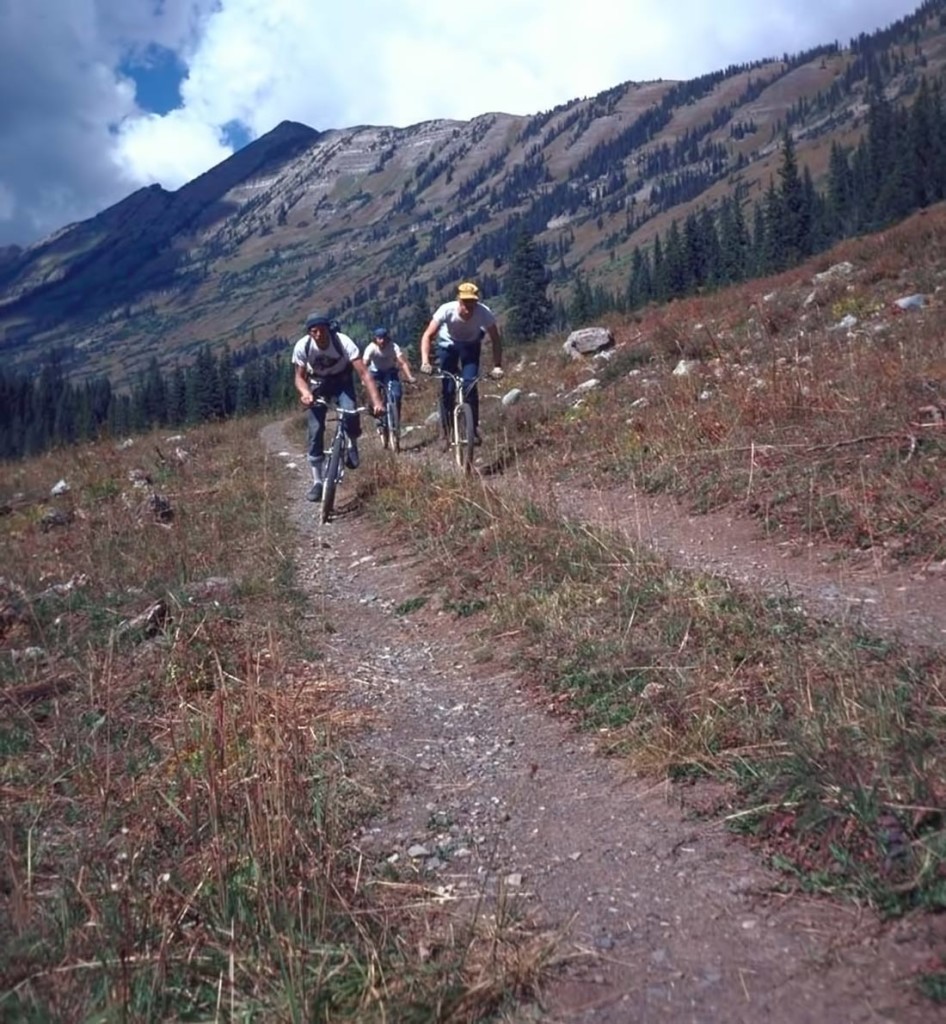 From here on there are no attempts to regroup as the rough road and steep climb separate the riders widely. The bikes from California are all multi-speeds, and with this technological edge the west coast riders are the first to reach the campsite at 11,000 feet.
From here on there are no attempts to regroup as the rough road and steep climb separate the riders widely. The bikes from California are all multi-speeds, and with this technological edge the west coast riders are the first to reach the campsite at 11,000 feet.
Duane has already arrived in the support truck with all the essentials, food, sleeping bags, and a keg of beer. Riders straggle into camp for the next hour and a half and bikes and bodies are thrown on the ground as everyone tries to find a lungful of what passes for air at this elevation.
The sky has begun to cloud up, and a few anxious eyes turn skyward. Those who have tents pitch them immediately as a few drops of rain fall, but the threat moves on, and by sunset the sky is clear. In contrast to record cold several nights previously, the temperature stays around 50 degrees all night, a rarity at this altitude, and although there is no moon, the stars are so brilliant and numerous that there is enough light to see by.
Dinner consists of steaks cooked on an open fire. Perhaps it is the altitude or the work involved in getting there, but everyone agrees that it is one of the best meals they have ever had. Talk around the fire is dominated by discussion of amazing exploits by locals and, since many of the men from Crested Butte work on fire crews during the summer, best ways of cooking on a forest fire. Some of the stories are entering into their third rendition as we slip off to bed.
The next morning dawns warm but overcast. The fire is stirred back to life and a very quiet group stands around it eating breakfast and occasionally castigating Duane for not bringing any coffee.
No one seems to be in a rush to break camp, and two riders, inc1uding one of only two women on the tour, announce their retirement. Finally, after much procrastination, a gradual exodus begins toward Pearl pass.
The road to the top of the pass is the worst yet encountered. As we approach and then pass timberline, soil becomes a rare commodity, and the surface turns to loose rock. Gradients which would normally be ridable are impossible in the thin air, and the three and a half mile final assault takes most of the crew well over an hour.
Having recovered from their hangovers, the Crested Butte boys are surprisingly tough. Starr, the oldest person on the ride, and by no means the most fit, arrives at the 12,705′ summit on pure determination.
Having expended so much effort getting there, no one is in a hurry to leave, so snacks are passed around, tire pressures checked, photos are taken, and the fine echo is demonstrated by a burst of Alpine yodeling.
The wind is biting here, so when no more excuses are available, everyone lines up at the top of the descent, reminding each other that this a tour, not a race.
Then Starr booms out, “As elder statesman of the Crested Butte to Aspen bike tour, I declare this course open!”
Thus begins some of the roughest cycling available anywhere. The road over Pearl pass was built in 1884 for mule trains to bring ore from Aspen to the railhead at Crested Butte. There has been no maintenance for 50 years or so.
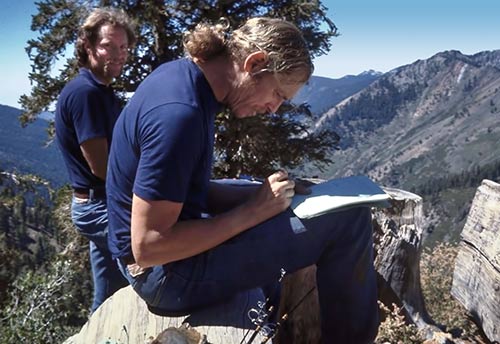 On the Aspen side of the pass the road is all loose rock and the rocks average around the size of a watermelon. It takes half an hour or more to cover the seven miles downhill to the paved road and during that time the rider feels as though he is trapped on a paint shaker. Legs and arms are soon aching from the shock and hands go numb from hanging onto brake levers. There is no relief except by stopping, and even though this is a “tour,” no one wants to be last. Everyone stops at least once on the descent for rest and cooling of overheated coaster brakes.
On the Aspen side of the pass the road is all loose rock and the rocks average around the size of a watermelon. It takes half an hour or more to cover the seven miles downhill to the paved road and during that time the rider feels as though he is trapped on a paint shaker. Legs and arms are soon aching from the shock and hands go numb from hanging onto brake levers. There is no relief except by stopping, and even though this is a “tour,” no one wants to be last. Everyone stops at least once on the descent for rest and cooling of overheated coaster brakes.
Finally we reach pavement and from here it is 15 miles to Aspen, downhill with a tailwind. After regrouping, we shove off again, and the leaders finish at close to 40 mph over this last stretch. Stopping just outside Aspen by prearrangement, everyone attaches balloons to the seatstays in order to make the noisiest possible entrance. As we pull up in the middle of town a case of beer appears on the sidewalk and vanishes amid cheers.
One bike was destroyed on the pass and arrives in the sweep vehicle. A few passersby ask what is going on, and when they are told the nature of the exploit, they are impressed to the point of disbelief.
For the most part, however, our presence in Aspen is ignored by the citizenry, so we enter the nearest public house. All that is left from our $15 entry fees, about $60, is laid on the bar and the serious bragging begins.
The organization of rides back to Crested Butte is a little shaky, but eventually a beat-up flatbed truck roars in, sans muffler, to pick us up. There being no options, we wedge all of the bikes and most of the riders into the back for the three hour drive back.
Starr, who had been saying, “Never again,” is talking about next year’s ride, and what a great support driver he’ll be.
We arrive back in Crested Butte well after dark, but most of the gang has the strength left for a little more beer and a lot more bragging. A trip to the community hot tub-sauna caps off the days adventure.
The next morning we said goodby to half the people in Crested Butte. Having arranged for our truck to be dropped off on the other side, we rode over 10,000′ Kebler pass, an eight mile climb followed by an eighteen mile descent of 4000′, all dirt and gravel road.
If scenery were edible, the entire population of China could be fed here. The view is redundantly spectacular, as we ride through multicolored aspen forests and down lush valleys shadowed by treeless peaks, but finally we come to something distasteful.
It is the truck, signifying a return to the reality of the trip home.

